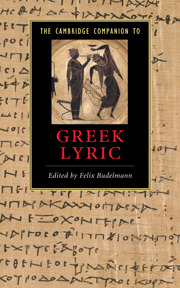Book contents
- Frontmatter
- Introducing Greek lyric
- Part I: Contexts and topics
- Part II: Poets and traditions
- 8 Iambos
- 9 Elegy: Forms, functions and communication
- 10 Alcman, Stesichorus and Ibycus
- 11 Alcaeus and Sappho
- 12 Anacreon and the Anacreontea
- 13 Simonides, Pindar and Bacchylides
- 14 Ancient Greek popular song
- 15 Timotheus the New Musician
- Part III: Reception
- Chronology of select melic, elegiac and iambic poets
- Further Reading
- Glossary
- List of works cited
- Index
13 - Simonides, Pindar and Bacchylides
from Part II: - Poets and traditions
Published online by Cambridge University Press: 28 May 2010
- Frontmatter
- Introducing Greek lyric
- Part I: Contexts and topics
- Part II: Poets and traditions
- 8 Iambos
- 9 Elegy: Forms, functions and communication
- 10 Alcman, Stesichorus and Ibycus
- 11 Alcaeus and Sappho
- 12 Anacreon and the Anacreontea
- 13 Simonides, Pindar and Bacchylides
- 14 Ancient Greek popular song
- 15 Timotheus the New Musician
- Part III: Reception
- Chronology of select melic, elegiac and iambic poets
- Further Reading
- Glossary
- List of works cited
- Index
Summary
The surviving corpus of Pindar includes something unique in the remains of early Greek melic poetry: a large number of complete poems that come to us by way of a direct manuscript transmission. We will consider below how and why his four books of epinikia enjoyed this privileged mode of preservation; for now we will only remark that the fact of it conditions the way in which we perceive his relationship to Simonides and Bacchylides, which in turn conditions how we perceive the milieu inhabited by all three (henceforth, SP&B).
Why do we group these three poets together? Because they worked as contemporaries, and in certain senses as competitors, before many of the same audiences and in the same poetic genres, which they brought to a peak of artistic perfection and cultural importance. Contributing to their achievement's appearance of finality was the rise of Attic drama. The record of survival to our own era (which was to a certain extent accidental) contributes to this implied narrative of displacement: most of the datable work of SP&B belongs to the first third of the fifth century, and peters out as the second opens with the earliest surviving plays of Aeschylus. One reason SP&B seem to form a climax, then, is that their tradition was not continued by practitioners of comparable talent: ambitious younger poets were mostly drawn to tragedy and comedy, the poetic genres that have most abundantly survived from the fifth century. It should be kept in mind, however, that one of the features of Attic drama that made it so successful was its facility at absorbing other genres, especially those of lyric, which provided the chief models for its choral songs. If tragedy superseded lyric, it did so in part through co-optation.
- Type
- Chapter
- Information
- The Cambridge Companion to Greek Lyric , pp. 240 - 262Publisher: Cambridge University PressPrint publication year: 2009
- 5
- Cited by



